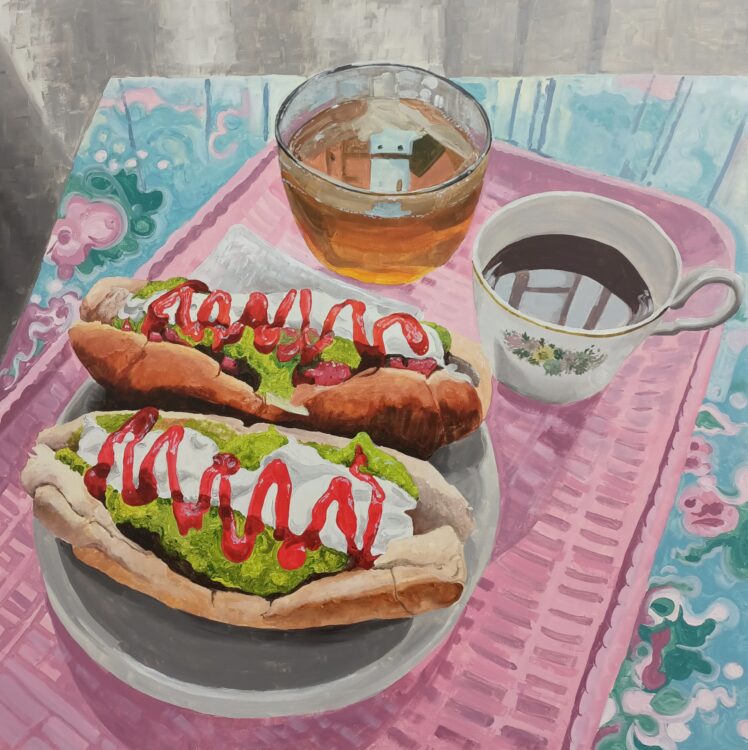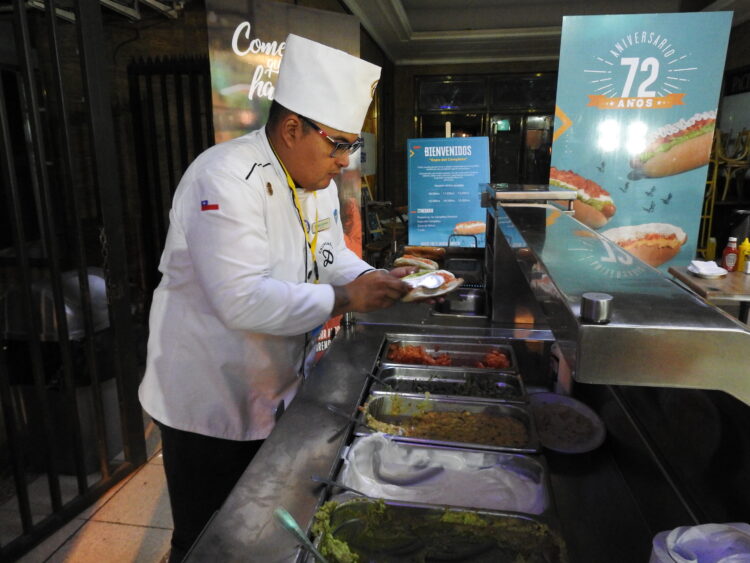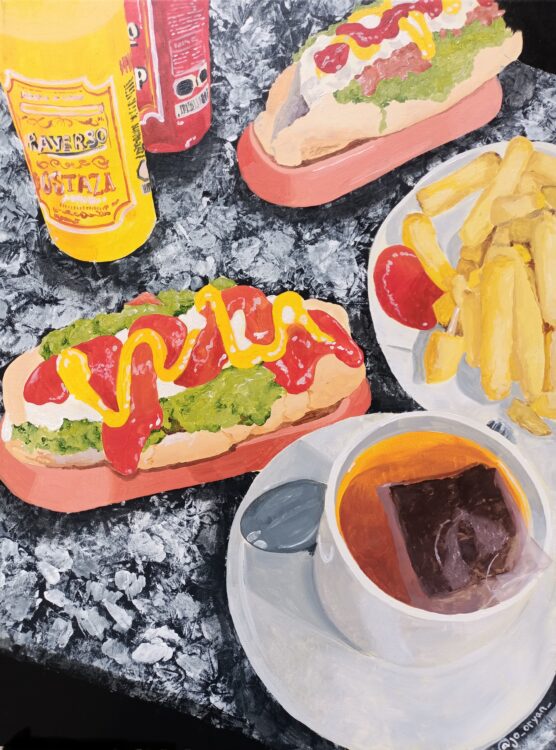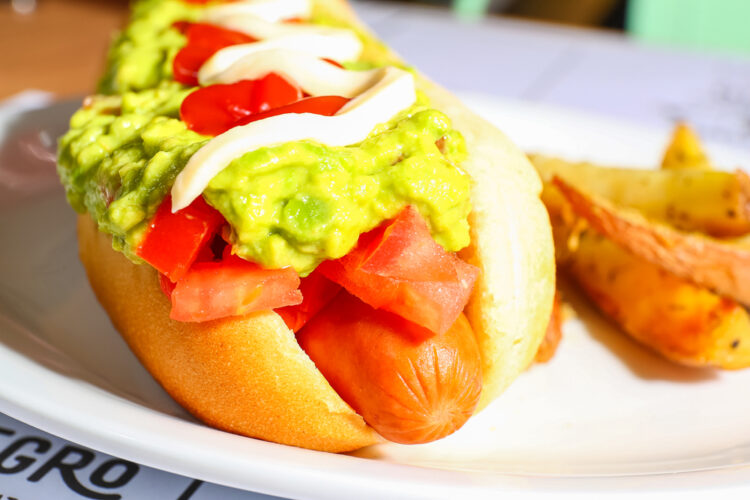As the chef proudly leans across the counter to hand me my lunch, a few pieces of chopped tomato plop onto the floor.
He smiles sympathetically, knowing that by the end of the meal, I’ll be a mess. There’ll be sauce on my shirt, avocado on my jeans, and a splodge of mayonnaise on the floor. I expect he’s already alerting the cleaners: “get ready, a foreigner is eating a completo.”
The completo is practically the national dish in Chile, and at its heart, it’s just a well-dressed hot dog. The sausage itself is swamped by a mountain of toppings, like chopped onions, tomatoes, sweetcorn, mashed avocado, chili, cheese and bacon. Some come with sauerkraut, scrambled egg, and even a smattering of nuts. Clusters of sauce bottles are standing by too, in case your completo doesn’t feel complete enough.
The result is a dauntingly large creation that stretches the mouth and messes the surroundings. But it’s cheap, cheerful, fast, and quintessentially Chilean, loved by all ages and social classes.

“The completo is an icon – it’s the most popular food in Chile,” says Rodrigo Alvedo, manager of the Dominó restaurant chain. “People eat them for breakfast, tea hour, lunch and dinner. It’s called a completo because we put a lot of things in the bread with the sausage – all the things you can think of. It’s easy to make and so versatile, there’s nobody in the world that doesn’t like completos.”
Just how beloved is this gastronomic oddity? Well, every May 24 is National Completo Day, and this year an art exhibition paying homage to the sausage and its over-the-top toppings was staged in a public gallery.
As for its history, the story goes that restaurant owner Eduardo Bahamondes Muñoz first encountered the hot dog when he traveled to the US in 1930. He bought the idea back to Santiago, but local tastes weren’t impressed by ketchup and mustard. So he added tomatoes, avocado… and anything else they fancied.
After he died, the business was bought by a family of Italian immigrants, headed by Jose Devillaine. They’re credited with creating the ‘Italian’ version, a modest mix of avocado, tomato and mayonnaise.
Don Bahamondes would be thrilled to see the gastronomic wave he inspired. Now in the heart of Santiago, tourists stroll around the elegant Plaza de Armas with its cathedral, ornate post office, and ancient Palacio Real. But locals aim for the southern side of the plaza, where one whole historic alleyway is devoted to this Chilean staple. Every shop in Portal Fernández Concha has a window display of hot dogs, enticing you to enter their long, narrow interiors.
A few streets away is the original branch of Dominó, a family business with a 72-year history. The outlet that first opened in 1952 sells about 1,500 completos every day, while overall its 38 branches sell a daily average of 20,000.
Dominó launched Completo Day in 2009, and this year it staged workshops on how to create the perfect package. But I raised a cynical eyebrow when Rodrigo enthusiastically described the chef as a maestro of his craft. A maestro of something so simple? Yes, Rodrigo answered. “It’s basic, but you develop your own style, your own speciality. He adds the magic.”
Chef Matias Carrasco is indeed a master of the art. He wields his spoon dexterously to lather on just the right amount of avo, sprinkles on some sweetcorn, and artfully drizzles a pattern of sauce on top. When he hands it over, it’s with obvious pride and pleasure.

Matias also keeps customers hooked by incorporating new flavours. “We created a new version for the presidential election, and we’ve incorporated flavours that aren’t traditionally used in Chile, like Kimchi, to make sure our clients don’t get bored,” he says.
Yet his personal favourite is the Italiano. “The truth is, we think less is more. The Italiano only has three toppings – avocado, mayonnaise and tomato. So it doesn’t have many flavours but they all work perfectly together. It’s a classic and it’s the best seller.”
For something a little saucier, the Centenario created for the 2015 America’s Cup includes pancetta and BBQ dressing. A Lo Pobre comes with a fried egg, fried onions and cheese. And if you’re in a hurry, order a Comptelo en ambulancia for a high-speed emergency response.
As Mathias explains, the cooking process is precise. Dominó’s sausages are made of pork, not beef, and come from the rural south of Chile, an area full of lakes and farms. The sausages are heated in oil at a certain temperature until they slightly inflate – too hot and they go hard, too cool, and they go flabby. The bread, baked specifically for Dominó by another supplier, is cut to make a big gap for the filling without splitting the two halves. It’s slightly toasted before the fillings are added, and ideally, toasted a touch more before it’s sold.
Since its size almost doubles once you add every conceivable topping, eating it without a mishap is half the fun. It’s a skill that artist Josefina O’Ryan captures perfectly in her series of vivid paintings, Amor Completo. “I believe that food is the best way of getting to know and understand a culture,” she says. “For us the completo isn’t only a hot dog – it has an important cultural significance. It’s an iconic culinary item that appears throughout our lives – at birthday parties, afternoon tea, at meetings or on a date. People also sell completos to raise funds for people in need.”

The ingredients are also culturally important since avocado and tomato are prolific in the country, while homemade mayonnaise recipes are passed down through the generations.
Her paintings are based on photos that she took in cafes and ‘soda fountains’, some of which have existed for decades and still have their original furniture and décor. People recognize their daily lives in her paintings, and she’s sold some to Chileans living abroad who crave a nostalgic remainder of what it means to be Chilean.
If you’re planning a trip to Chile, get your jaws in shape and your napkins ready, and make sure completos are on your menu.


